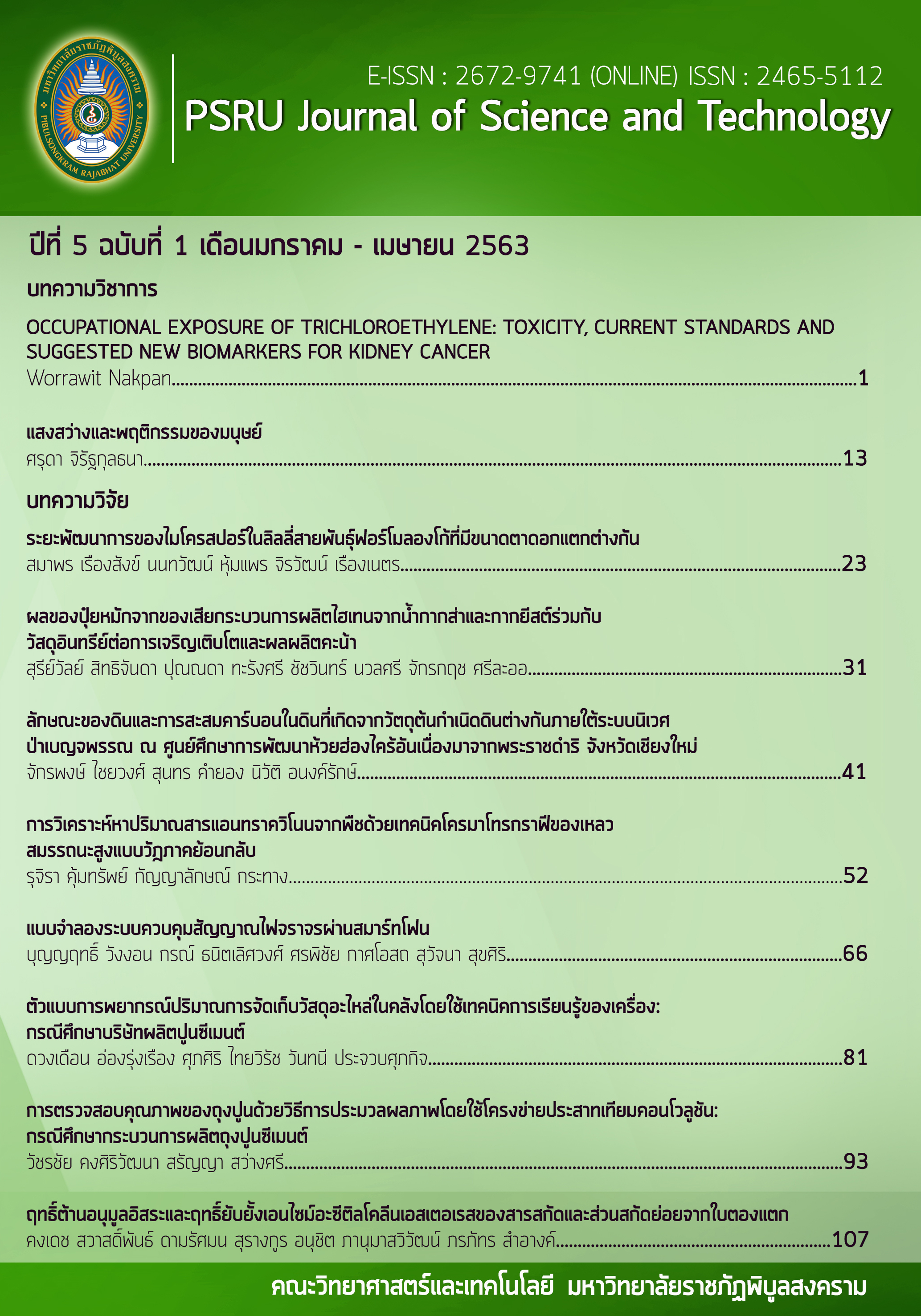QUANTITATIVE ANALYSIS OF ANTHRAQUINONE FROM PLANTS BASED ON REVERSED-PHASE HIGH PERFORMANCE LIQUID CHROMATOGRAPHY
Keywords:
Anthraquinone, High performance liquid chromatography, Reversed-phaseAbstract
The purpose of the research was study to evaluate the simultaneous quantitation of four anthraquinone compounds, namely anthraquinone, alizarin, chrysophanol and emodin in 8 plants include root of Noni (Morinda citrifolia L.), Cassia fistula L. (pulp, seeds, peel and leaves), Cassia siamea leaves, Rosell seeds and Basil seeds by High Performance Liquid Chromatography. For component separation, the method utilized a C18 column (150×4.6 mm, 3.5-Micron) in reverse phase with isocratic elution using a mobile phase of 0.1% v/v Ortho-phosphoric : Acetonitrile (50 : 50 v/v). Wavelength of 254 nm was used for detection. The results of determine anthraquinone compounds, anthraquinone, alizarin and emodin were found in the Noni roots. Chrysophanol was found in only pulp and seeds of Cassia fistula L. sample. Alizarin and emodin were found in Basil seeds sample and anthraquinone was found in Cassia siamea Britt leaves. The validation of the chromatographic method was performed that the linear calibration curves were obtained over the concentration range of 0.5-10.0 µg/mL for anthraquinone alizarin chrysophanol and emodin with good correlation coefficients (R2 > 0.9995). The accuracy of the method was reported as the recovery in the range of 75.1-106.8%. However, this method gave satisfactory precision in terms of relative standard deviation (RSD) value in the range 0.2–2.0% (n=7).
References
สมศักดิ์ นวลแก้ว. (2542). การเปรียบเทียบปริมาณแอนทราควิโนนและรูปแบบไซโมแกรมของไอโซไซม์ในพืชสกุลแคสเซีย. (วิทยานิพนธ์ปริญญามหาบัณฑิต). มหาวิทยาลัยมหิดล, สาขาวิชาเภสัชศาสตร์ (เภสัชเคมีและพฤกษเคมี).
Ain, N. J., Sakinah, M. A. M. & Zularisam, A.W. (2016). Effects of Different Extraction Conditions on The Production of Anthraquinone . Australian Journal of Basic and Applied Sciences, 10(17), 128-135.
AOAC. (2002). Official Method of Analysis. (16th ed). Washington DC : Association of Official Analytica.
Chewchinda, S., Sithisarn, P., & Gritsanapan, W. (2014). Rhein Content in Cassia Fistula Pod Pulp Extract Determined by HPLC and TLC-Densitometry in Comparison. Journal of Health Research, 28(6), 409-411.
Duval, J., Pecher, V., Poujol, M., & Lesellier, E. (2016). Research advances for the extraction, analysis and uses of anthraquinones: A review. Industrial Crops and Products, 94, 812–833.
Kumar, H.& Spandana M. (2013). Qualitative and Quantitative Study of Anthraquinone Derivatives in the Root Extract of Rheum australe of Nepal (syn.Rheum emodi) by HPLC. Journal of Pharmacognosy and Phytochemistry, 2(4), 40-42.
Monton, C., Duangjit, S., Chankana, N., Charoenchai, L. & Suksaeree, J. (2017). The Optimazation of the Anthraquinones Extraction from Senna tora Seeds Using Two-Factor Spherical Composite Experimental Design. Proceedings of the RSU International Research Conference, Rangsit University, Bangkok, 28th April 2017, 88–96.
Sakulpanich, A. & Gritsanapan, W. (2009). Determination of Anthraquinone Glycoside Content in Cassia fistula Leaf Extracts for Alternative Source of Laxative Drug. International Journal of Biomedical and Pharmaceutical Sciences, 3(1), 42-45.
Sakulpanich, A, Chewchinda, S., Sithisarn, P. & Gritsanapan, W. (2012). Standardization and toxicity evaluation of Cassia fistula pod pulp extract for alternative source of herbal laxative drug. Pharmacognosy Journal, 4(28), 6-12.
Shi YB., Li HL., Wang HQ., Yang YB., Zhang XY., Wang H., Zhu ZJ., Zhang ZY., & Zhang CA. (2014). Simultaneous determination of five anthraquinones in a Chinese traditional preparation by RP-HPLC using an improved extraction procedure. Journal of Integrative Medicine, 12(5), 455-62.
Sihanat, A., Palanuvej, C., Ruangrungsi N. & Rungsihirunrat, K. (2018).Estimation of Aloe-emodin Content in Cassia grandis and Cassia garrettiana Leaves Using TLC Densitometric Method and TLC Image Analysis. Indian Journal of Pharmaceutical Sciences, 80(2), 359-365.
Temiyaputra,W., Suebsanga, T., Yajom, K., Piyaworanon, S. & Leksawasdi, N. (2008). Influences of Anthraquinone Extraction Techniques from Morinda sp. on Extraction Efficiency. Kasetsart Journal Natural Science, 42, 118–126.
Downloads
Published
How to Cite
Issue
Section
License
กองบรรณาธิการขอสงวนสิทธิ์ในการปรับปรุงแก้ไขตัวอักษรและคำสะกดต่างๆ ที่ไม่ถูกต้อง และต้นฉบับที่ได้รับการตีพิมพ์ในวารสาร PSRU Journal of Science and Technology ถือเป็นกรรมสิทธิ์ของคณะวิทยาศาสตร์และเทคโนโลยี มหาวิทยาลัยราชภัฏพิบูลสงคราม และ
ผลการพิจารณาคัดเลือกบทความตีพิมพ์ในวารสารให้ถือมติของกองบรรณาธิการเป็นที่สิ้นสุด







